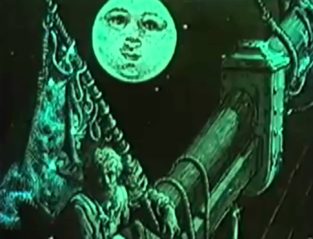 This medium-length 1977 film showcases the work of four great artists: Samuel Taylor Coleridge, who wrote the immortal poem “The Rime of the Ancient Mariner”; Gustave Dore, who provided the still-unsurpassed illustrations to the text; Orson Welles, who reads the poem in his inimitable baritone; and filmmaker Larry Jordan, who integrated all these elements.
This medium-length 1977 film showcases the work of four great artists: Samuel Taylor Coleridge, who wrote the immortal poem “The Rime of the Ancient Mariner”; Gustave Dore, who provided the still-unsurpassed illustrations to the text; Orson Welles, who reads the poem in his inimitable baritone; and filmmaker Larry Jordan, who integrated all these elements.
Samuel Taylor Coleridge’s “The Rime of the Ancient Mariner” was originally published in 1798 and revised in 1834. Gustave Dore’s stunningly illustrated version arrived in 1875, and is believed by many (myself included) to be among the legendary illustrator’s finest work.
Larry Jordan’s 42-minute film version appeared over 100 years later. Jordan is a famous underground filmmaker best known for OUR LADY OF THE SPHERE (1969) and SOPHIE’S PLACE (1987). His style tends to consist of cut-out animation superimposed over Nineteenth Century-era paintings and illustrations (not unlike the collage novels of Max Ernst). This in my view makes Jordan the perfect choice to render Coleridge’s poem and Dore’s illustrations in cinematic form.
Orson Welles had a vocal range like no one else. In the 1960s and ‘70s he did readings of several classic texts, among them Jack London’s “To Build A Fire” for director David Cobham’s 1969 film adaptation. For “The Ancient Mariner” Welles, with the help of his cohort (and future crap movie maestro) Gary Graver, allegedly recorded each line of the poem several times over until he got the readings absolutely right, leaving it up to Jordan to string the recitations together.
Other cinematic renderings of Coleridge’s masterpiece include a 1975 animated version by Raul DeSilva and Paul Bush’s 1998 film THE ALBATROSS, which also utilizes Dore’s illustrations.
The story: A carefree young man, a guest at a friend’s wedding, is cornered by a creepy old guy who identifies himself as a Mariner. He insists on telling his story, which transfixes the wedding guest, about a doomed sea voyage to Antarctica.
According to the Mariner’s tale, after sailing through various ice-bound landscapes his ship is guided out of the region by an albatross. The Mariner, however, stupidly shoots the albatross with an arrow. His shipmates initially shun him but once they reach calm waters change their tune, not realizing the ship and its inhabitants are cursed.
Before long the ship is adrift in windless waters (“as idle as a painted ship upon a painted ocean”) leaving its inhabitants stranded without sufficient food or water (“water, water everywhere, nor any drop to drink”). The crewmembers renew their hatred of the Mariner, and hang the dead albatross around his neck as a reminder of his crime.
But then the ship is approached by an eerie black sea vessel. Upon it Death rolls dice with a white-robed woman for the lives of the Mariner and his shipmates. The woman wins the roll, meaning the Mariner gets to live and his shipmates die. This comes to pass, and the Mariner is left alone on the idling ship. Yet he’s moved to bless the sea creatures he once cursed, and the albatross falls from his neck.
From there the ship is destroyed in a whirlpool and the Mariner escapes by hitching a ride on a rowboat. Back on land he finds that the only way he can get any peace is by telling his tale to anyone he can find, with the wedding guest being the latest (but far from final) listener.
Larry Jordan pays Coleridge’s tale and Dore’s etchings the utmost respect, but still adds quite a bit of his own to the film. Viewers of any of Jordan’s other films will recognize the constantly shifting color schemes and various bits of ephemera that periodically drift across the screen, superimposed over Dore’s backgrounds: birds, a smiley-faced sun and the woman-with-a-globe-head who turns up in quite a few of Jordan’s animations. Other Jordan trademarks include periodic flashing and buzzing, emitting more often than not from tiny objects stationed near the edges of the frame. All in all the film looks and feels like one of Jordan’s more odd and esoteric efforts, highlighting the underlying weirdness of the poem (which many scholars believe was conjured during one of Coleridge’s not-infrequent opium trips).
Orson Welles’ authoritative and dramatic reading of the text is superb, as you might expect, and Jordan does a good job synchronizing the artwork with it. Oft-times he’ll pan or zoom through the pictures, emphasizing certain details and allowing for a renewed appreciation of the extraordinary complexity of Dore’s art.
The film, in the end, is both appropriately reverential and deeply trippy. I haven’t seen the other adaptations of this poem, but can’t imagine they can possibly be any better than this one.
Vital Statistics
THE RIME OF THE ANCIENT MARINER
Studio Films
Director/Producer/Cinematographer/Editor: Larry Jordan
Cast: Orson Welles
